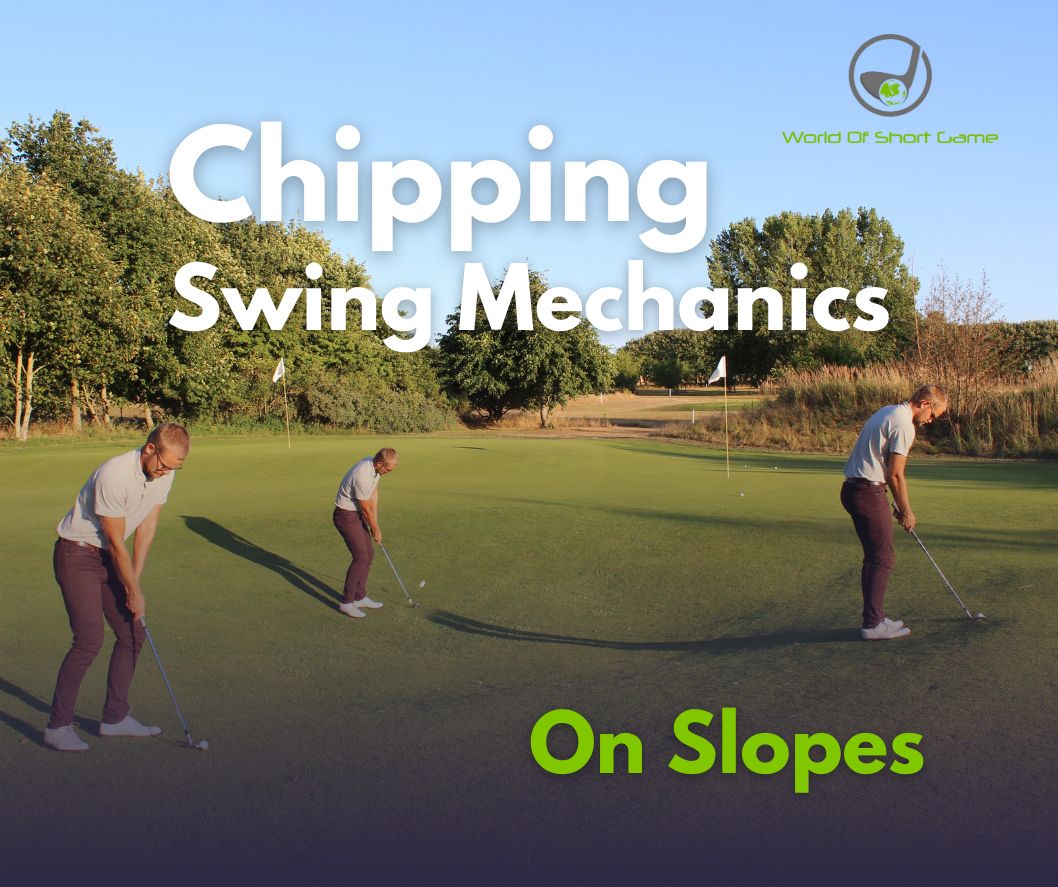- +4527976587
- mail@worldofshortgame.com

Chipping Swing Mechanics on Slopes

Chipping Swing Mechanics on Slopes
Chipping Swing Mechanics on Slopes: A Comprehensive Guide
When chipping from sloped lies, understanding the geometry of the swing and how to adjust to different slopes is essential for maintaining control and precision. Whether the ball is above or below your feet, your swing mechanics must adapt to the unique angles and heights created by the terrain. In this guide, we’ll dive into the fundamentals of chipping swing mechanics on slopes, focusing on how to adjust your setup, swing radius, and shoulder positioning to achieve better contact and consistency.
Understanding the Geometry of the Swing on Slopes
The geometry of the swing changes drastically on sloped lies. Unlike flat lies, the distance from the ball to your club is altered, and this requires changes in both your swing radius and the center of your swing, which is typically aligned with your left shoulder.
Chipping with the Ball Below Your Feet
When the ball is below your feet, it becomes more challenging to make solid contact because your club naturally sits higher than the ball. To adjust:
Looking to improve your short game? I'm currently offering online lessons through the Skillest app with a 50% discount on your first lesson for all readers of the World of Short Game blog. Simply use the promo code "WOSG50percent" when booking your first session to get started at a discounted rate. Let’s work on your game together! ⛳️
A. Moving the Swing Center (Left Shoulder) Closer to the Ground
To ensure the clubhead reaches the ball, you need to lower the center of your swing. The key adjustment here is to increase the forward bend at your hips, moving your left shoulder closer to the ground.
- Why It Works: By bending forward more, you bring the swing plane lower, allowing the club to contact the ball correctly despite the slope. This change helps to level the distance between the ball and the clubhead.
- Hip Angle Change: In situations where the ball is below your feet, your hips should be at a steeper angle than in flat lies. This forward tilt compensates for the ball’s lower position.
B. Maintain Balance and Stability
A common challenge with this setup is maintaining balance. As you bend more, you may feel off-balance. To counteract this:
- Widen your stance for stability.
- Keep your weight centered, focusing on a smooth, controlled swing.
Chipping with the Ball Above Your Feet
When the ball is above your feet, the situation is reversed. The ball is closer to your body, making it necessary to adjust your stance and swing radius to avoid hitting fat or pulling the shot left.
A. Standing Taller and Reducing Forward Bend
To adapt, stand taller with less forward bend in your hips. This raises your left shoulder, moving the center of the swing higher to match the ball’s elevation.
- Hip Angle Change: When the ball is above your feet, your hips will be less bent compared to a flat lie or when the ball is below your feet. This helps ensure your swing remains on-plane with the ball’s height.
B. Shortening the Swing Radius by Gripping Down
Another crucial adjustment when the ball is above your feet is to shorten the swing radius. You can do this by gripping further down on the club, effectively shortening the distance from your left shoulder to the clubhead.
- Why It Works: Shortening the club by gripping down helps to match the shorter distance between the ball and your body. Without this adjustment, you risk hitting the ball too early or too steeply.
C. Adjusting for Directional Changes
When chipping with the ball above your feet, your hands naturally sit higher, which can cause the clubface to point more to the left. To compensate:
- Aim slightly right to counteract the leftward bias.
- Open the clubface slightly if necessary, depending on the desired shot trajectory.
Combining Swing Mechanics for Effective Adjustments
Understanding how to combine the changes in your swing radius and the center of your swing can help you chip more consistently from any slope.
- On a Downslope (Ball Below Feet): Increase forward bend, grip further up on the club, and focus on staying balanced throughout the swing.
- On an Upslope (Ball Above Feet): Stand taller, grip down on the club, and aim slightly right to counteract the natural leftward bias of the clubface.
Mastering the Art of Consistency on Slopes
The key to successful chipping on slopes is practicing these adjustments until they become second nature. It’s important to experiment with different slopes and lies during practice sessions, so you can develop a feel for how much to adjust based on the severity of the slope.
- Practice Tip: Spend time practicing on uneven surfaces to get comfortable with changing your setup, balance, and swing mechanics. Focus on keeping your left shoulder and body aligned with the slope to maintain proper contact.
Conclusion: The Importance of Adapting to Slopes
In summary, mastering chipping swing mechanics on slopes is all about adjusting to the geometry of the terrain. By understanding how to move the center of your swing, modify your stance, and adjust the swing radius, you can effectively handle both uphill and downhill lies. Whether the ball is above or below your feet, applying these principles will lead to cleaner, more consistent chip shots.
Looking to improve your short game? I'm currently offering online lessons through the Skillest app with a 50% discount on your first lesson for all readers of the World of Short Game blog. Simply use the promo code "WOSG50percent" when booking your first session to get started at a discounted rate. Let’s work on your game together! ⛳️
You must be logged in to post a comment.



